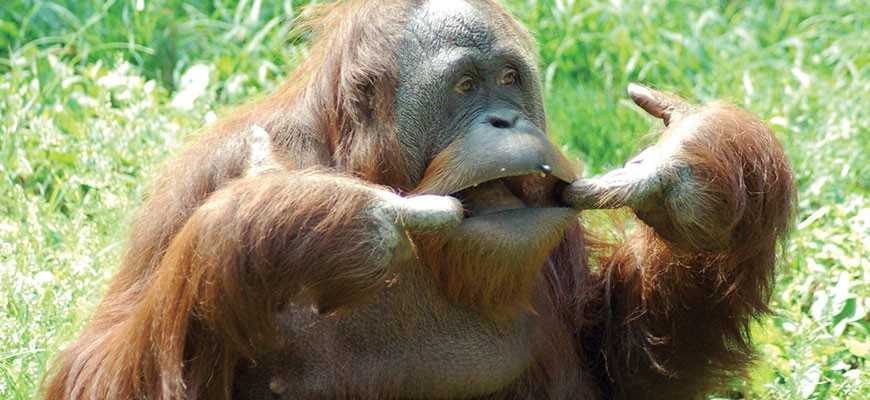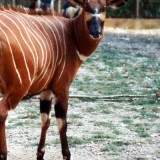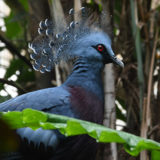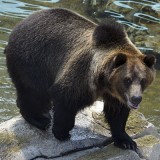DESCRIPTION & SIZE
The orangutan is the largest tree-living animal in the world. Males stand approximately 4½ ft. and weigh approximately 90 kg (200 pounds.). Females stand approximately 3½ ft and weigh about 50kg (110 pounds.). The body is covered with a dark rufous or reddish brown, rather thin, shaggy coat. The arms are 1½ times longer than the legs and from fingertip to fingertip can measure as long as 8 feet in large adult males. The shoulder and hip joints are extremely supple, allowing each limb to move easily in any direction. The feet and hands are almost identical. The thumbs are comparatively much shorter than those of other ape species, as longer thumbs would inhibit swinging through the trees. The feet are also prehensile to aid in grasping. The Sumatran orangutans tend to be lighter in color and have longer thicker hair than the Borneans. The most striking difference between the two are the faces of the adult males. The Bornean male adults develop large cheek flanges as they sexually mature. These grow outward and forward from the skull, giving the face a concave shape. The Sumatran males develop cheek flanges that grow sideways rather than forward, giving the face a more flattened look. The Sumatrans also tend to grow longer beards and moustaches than the Borneans.
RANGE
Orangutans are currently found on the island of Borneo, which is divided between the nations of Malaysia and Indonesia, and on the northern tip of the Indonesian island of Sumatra. Historically orangutans ranged throughout much of Southeast Asia. The two separate subspecies have been isolated from each other for over one million years, with no route of gene flow between the two. This has prompted some scientists to propose that they are actually two distinct species, as different as chimpanzees are from bonobos. (In April of 2000 this new classification was jointly advocated by Conservation International, IUCN/SSC Primate Group, and the Center for Environmental Research and Conservation.)
BEHAVIOR
Orangutans are primarily solitary. Although they are capable of forming strong social attachments, their size and arboreal lifestyle prevent this since the fruit-bearing trees they inhabit would not be able to physically support large groups, or provide enough fruit to sustain a large group. The bond between mother and offspring is strong and the infant stays with its mother for up to ten years. This is the longest childhood of any ape species. Adult females with young often form short-term groups and sub-adult males sometimes associate with adult females. Adolescent females also sometimes travel together when the age difference is minimal. Mature males are generally intolerant of each other. Approximately 60% of the daylight hours are spent in search of, and consuming, food. Each night a new nest is built approximately 40 or 50 feet up in a tree. Although orangutans are almost exclusively arboreal, males will come to the ground to move between stands of trees. Because of their larger bulk, the males tend to stay lower in the canopy than the females, which reduces competition for food when their ranges overlap. Tool use in both wild and captive orangutans has been well documented. This includes making items to scratch with, probe for food with, making umbrellas, and even using sticks to create ladders and bridges. Imitating human behaviors with tools is also documented in captivity and at rehabilitation camps.
REPRODUCTION
Females reach sexual maturity between the ages of eight and twelve, although in the wild they don’t usually give birth until a few years later. The estrus cycle is generally 28 – 32 days. Gestation is 233 – 265 days. The single young is born weighing approximately 1.5 kg (3½ lbs.). Because of the solitary nature of this ape, the bond that forms between mother and offspring is very strong and females do not give birth again for five years, sometimes as long as eight years. This makes the reproduction rate of orangutans the slowest of any of the great ape species. Males reach puberty at approximately age seven or nine, but the cheek pads, which are considered secondary sexual traits, may not be fully developed until age 14 or even later. Researchers have reported for some time that females are not receptive to males until the males reach full maturity, with developed cheek pads and a well-developed throat sac capable of emitting loud cries known as long calls. They were also aware, however, that sub-adult males often forcibly copulate with females. Some believed that these males were incapable of impregnating the females but research now disputes this. Researchers have also found that males can stay in a state of arrested development for much longer than was once believed. These findings, regarding the arrested sexual development in male orangutans, have offered a new interesting theory regarding evolutionary strategies for this species. It is now believed that the presence of dominant males in the vicinity causes the arrested development of adolescent males. Since these males are capable of impregnating females it is believed the strategy is one of avoiding conflicts with adult males, while also needing less food to survive. Orangutans in AZA zoos were instrumental in discovering these findings as studies were conducted which tested hormone levels in juvenile, arrested adolescent, developing adolescent, and adult male orangutans. The discovery that males in a captive group of orangutans could stay in an arrested state as long as an adult male is still in the group, might have implications for how captive orangutans are managed in the future. (See Scientific American, June 2002).
LIFESPAN
In captivity, orangutans generally live 30 – 40 years, but can live upwards of 50 years. Lifespan for wild individuals is probably closer to 40 years.
DIET
Orangutans primarily feed on fruit. More than 300 different food items have been identified in their diet. Some of the fruits consumed include jackfruit, durian, langsat, mangosteen and breadfruit. Several of these fruits are very spiny and require “preparation” before eating, which is a procedure that young orangutans must learn from their mothers. In addition, orangutans feed heavily on bark, leaves and other plant parts, in addition to termites, caterpillars, ants, crickets and honey. The dentition differs from other ape species as the back molars contain a thicker layer of enamel. These teeth are capable of cracking even the hardest of nuts. The teeth, strength, and manual dexterity of the orangutan also allow it to feed on some tree barks that are not exploited by other species. These plant parts are high in fiber, which is digested with the aid of fiber-degrading bacteria in the large colon. In turn, fatty acids are secreted that are absorbed and used as a source of energy. A recent nutritional study of captive orangutans has led to the development of a very high fiber dietary gel. It is hoped this will better help meet the high fiber needs of these animals in captivity (St Louis Zoo ZUDUS March/April 2002).
HABITAT
Orangutans inhabit tropical rainforest as well as peat swamp forest. They primarily utilize the middle canopy. Large tracts of mature forests are needed to sustain this species. It is estimated that suitable orangutan habitat in Malaysia and Sumatra has declined by more than 80% in the last two decades.
CONSERVATION STATUS:
Orangutans are critically endangered. Both species have been listed as Endangered under the U.S. Endangered Species Act since June 1970 and covered under Appendix I of the Convention on International Trade in Endangered Species (CITES) since July 1975. Rampant exploitation and conversion of the tropical rainforest for a variety of human interests, primarily logging for industrialized countries, coupled with a booming human population in the area have contributed significantly to the alarming decline. Fires, both unintentional and intentional, have claimed the habitat and lives of many, or have flushed out individuals who are then slaughtered for food. In addition, the practice of killing mothers and selling their infants as pets has led to a staggering number of orphans in captivity. Current estimates put the wild Bornean population at approximately 12,000 and the Sumatran population at approximately 9,000.
SOURCES:
Beck, B (et al) 2001 Great Apes and Humans, The Ethics of Coexistence (Smithsonian Institution Press)
Kaplan, G., Rogers, L. 2000 The Orangutans (Persus Publishing);
Leach, M. 1997 The Great Apes, Our Face in Nature’s Mirror (Blanford)
Smuts, B. (et al) 1986 Primate Societies (University of Chicago Press)
Shaw, M., Wexo, J. 1996 Zoobooks Orangutans (The Knowledge Company)





